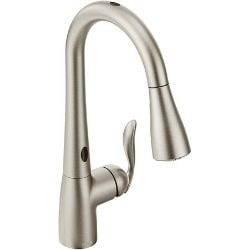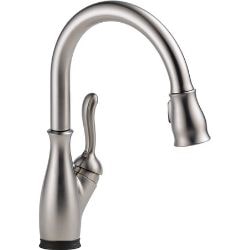Touch vs Touchless Faucet – What Are Differences?
Disclosure: Faucetshowerguide.com is reader-supported. We may receive commissions from purchases made via our links at no additional costs to you.
Are you going to upgrade your kitchen and bathroom with the latest appliances? Then don’t forget to upgrade the faucet. For modern bathrooms and kitchens, sensor faucets are perfect options.
There are 2 types of sensor faucets in the market – touch and touchless. Both types work when their sensors get the signal to start the flow of the water. There are differences in touch and touchless faucets. Before making a buying decision, you should read these differences to select the right sensor faucet for you.
What Is a Touch Faucet?

Unlike old-fashioned faucets that need to be turned by hand, a touch faucet uses electricity and sensors to operate. When they detect the touch, the sensors activate and start the flow of water. Touch faucet is also known as touch-activated faucets.
You know how sometimes you touch a doorknob or a metal object and you get a little zing of electricity? That’s because our bodies have natural electricity inside us. And guess what? Touch faucets use that same electricity to turn on and off.
When you touch the faucet, your body’s electricity transfers to the faucet through something called capacitance. It’s kinda like when you rub a balloon against your hair and it sticks to the wall – the same idea.
The electricity in your body activates the sensor of the faucet and the water comes out of the faucet.
But wait, you might be thinking, what if I accidentally turn on the faucet while cleaning it?
Don’t worry, the sensors in touch faucets are super smart and can tell the difference between a gentle touch and a deliberate tap. They’re designed to ignore those tiny cleaning touches, so you don’t have to worry about getting squirted unexpectedly.
Best Seller
Delta Touch Faucet Leland Pull Down Kitchen Faucet Chrome
No leakage due to diamond seal technology, A powerful magnet keeps the spray head in place, Easy installation process, and High arc design gives complete sink access
Pros and Cons of Touch Faucets
Pros
- Just need to touch the faucet with your hand, elbow, or any body part to turn it on. No need to use handles.
- It reduces contact with dirty handles that can spread germs. The hands-free operation helps promote germ-free hand washing.
- Touch faucets have a minimalist, high-tech aesthetic.
- Touch faucets often have shorter run times and auto shut-off sensors to prevent water waste.
Cons
- Touch faucets are generally more expensive than standard handle faucets. Installation may also cost more.
- Sensitive electronics can malfunction over time. So their repairs may be more complex and costly.
- The cheap touch faucet might turn on accidentally when just cleaning or bumping the faucet.
- Touch faucets require electricity or batteries to operate the touch sensors and solenoids. No power means no water.
What Is a Touchless Faucet?

Motion sensor faucets turn on and off without needing to physically touch them. They use sensors to detect your hand movements. Just wave your hand near the faucet and the water starts flowing. No need to touch anything on the faucet.
Touchless faucets are more convenient than touch faucets. With a touch faucet, you have to manually touch the faucet each time to turn it on or off.
The sensors in touchless faucets allow them to start working automatically. This makes them easier to use, especially when your hands are messy in the kitchen.
Different brands use different technologies for their touchless sensors. For example, Moen uses MotionSense and Pfister uses React. But they all aim to provide a hands-free experience.

Best Seller
Moen Arbor Motionsense Two-Sensor Touchless Kitchen Faucet
Stainless finish resists fingerprints and water spots, MotionSense provides an exceptional hands-free experience, Powerclean technology enables 50% more power
Check These - Best Selling Products on Amazon (Shop Now and Save Big)
Pros and Cons of Touchless Faucets
Pros
- Touchless faucets can help reduce the spread of germs and bacteria, as users do not need to physically touch the faucet handle to turn it on or off. This is especially beneficial in hospitals, clinics, and other healthcare settings where cleanliness is critical.
- Touchless faucets can be more convenient than traditional manual faucets, as they allow users to control water flow with a simple wave of their hand or elbow. This can be particularly useful when hands are full or dirty.
- Touchless faucets can help conserve water by automatically turning off the water supply when not in use.
- Touchless faucets can add an element of modernity and sleekness to a bathroom or kitchen design. They come in various styles and finishes, making them easy to coordinate with different decorating schemes.
- Many touchless faucets are relatively easy to install, require minimal plumbing work, and are often compatible with existing sink configurations.
Cons
- Most touchless faucets rely on batteries for power, which means that they require regular battery replacements. Some models have low-battery indicators, but others may unexpectedly stop working when the batteries die.
- While most touchless faucets have reliable sensors, some may misinterpret movement or fail to detect gestures correctly. This can result in erratic behavior, such as sudden shutoffs or continuous dripping of the touch faucet.
- Touchless faucets tend to be pricier than traditional manual faucets due to their advanced technology and features.
- Rarely, touchless faucets might experience interference from nearby objects or people, causing unintended activation or deactivation. This usually occurs when there’s a reflective surface or another motion-sensing device close by.
What Is The Difference Between a Touch vs Touchless Faucet?

There are two types of faucets: touch-activated and touchless. Touch-activated faucets need you to touch the faucet body to get water flowing. Touchless faucets use special sensors that can tell when your hands are nearby and start the water flow without you having to touch anything.
Touchless faucets are cleaner because you don’t have to actually touch the faucet, which can have germs on it. With touchless faucets, you can just wave your hand near the sensor and the water will come on. This is also more convenient when your hands are dirty or soap up.
Touchless faucets are usually more expensive than touch faucets because of the modern sensor tech. They might also cost more to install.
Touchless faucets need electricity to work. They either plug into a wall outlet or run on batteries. Touch-activated faucets don’t need any electricity because they work mechanically.
The sensors in touchless faucets might need some maintenance now and then, like changing batteries. Touch-activated faucets are easier to take care of since they have fewer moving parts.
Is a Touch or Touchless Faucet Better?
Yes, touch or touchless faucets are better. They maintain hygiene and are convenient to use.
These faucets reduce germ spread and water waste. But the price of these faucets is higher than traditional faucets.
If you can afford their high price, you should go with a touch-activated or touchless faucet.
How Long Do Touchless Faucets Last?
Touchless faucets can last for many years, but their lifespan depends on several factors, including the quality of the faucet, usage, and maintenance.
On average, a well-maintained touchless faucet can last for 10 to 20 years. However, some high-quality touchless faucets can last even longer, up to 30 years or more. If the touchless faucet is used frequently, it may not last as long as one that is used less often.
Areas with hard water may require more frequent maintenance and could potentially shorten the lifespan of a touchless faucet.
Check These - Best Selling Products on Amazon (Shop Now and Save Big)
Are Sensor Taps Safe?

Absolutely, sensor taps are very safe to use.
The sensors use harmless infrared or electric signals to detect your hands, no lasers or anything dangerous like that. They just see that your hand is there and activate the water.
They also prevent the spread of bacteria by limiting contact between different people’s hands and the faucet handle in public restrooms. Many sensor taps have an automatic shut-off if the sensor gets blocked or the water runs too long, preventing overflow or flooding.
Do Automatic Taps Save Water?

The sensors in automatic taps are a big water saver. They detect when your hands are under the faucet and turn the water on automatically.
As soon as you finish washing and move your hands away, the sensor shuts the water off. No more forgetting to turn taps off or letting them run too long. The sensors give you just the amount of water you need.
What Is The Difference Between Manual and Automatic Faucets?
Manual faucets are turned on and off by physically turning a handle or pressing a button, while automatic faucets use a sensor to control the flow of water.
When you place your hands under an automatic faucet, the sensor detects their presence and turns the water on. When you remove your hands, the water shuts off.
Automatic faucets are often considered more hygienic and convenient than manual faucets, as they do not require physical contact with the faucet itself.
Additionally, automatic faucets can be more water-efficient, as they only provide water when needed. However, they are typically more expensive than manual faucets and may require additional installation and maintenance.
Can a Faucet Turn on and off By Itself?
Yes, there are a few reasons a faucet could turn on and off by itself:
- Faulty solenoid valve
- Sensor malfunction
- Water pressure issues
- Mechanical failure of parts
- Cross-connection of appliances
Which Sensor Is Used In Automatic Taps?
Automatic taps work using a sensor. This sensor uses infrared light signals.
When your hands are near the tap, they block the infrared signals. This makes the sensor turn on the water flow. So the tap detects your hands are there and starts the water automatically.
You don’t need to touch the tap yourself. The infrared sensor sees your hands and turns on the water for you. That’s how the automatic taps are able to start the water flow without you touching them.
Check These - Best Selling Products on Amazon (Shop Now and Save Big)
How Do I Stop My Sensor Tap From Running?
There are a few reasons why your sensor tap might be running continuously. Here are some steps you should take to prevent the sensor faucet from running.
If the sensor range is set too high, it may detect movement even when there is none, causing the tap to run continuously. Adjust the sensor range to a lower setting to see if this resolves the issue.
Dirt, grime, or mineral buildup on the faucet sensor can cause false triggers, leading to continuous water flow. Clean the sensor with a soft cloth or brush to remove any debris.
Ensure that there are no obstructions blocking the sensor. If something is blocking the sensor, it may prevent the tap from turning off properly. Move any obstructions out of the way to see if this fixes the problem.
Weak batteries can cause intermittent issues with sensor taps. Try replacing the batteries with new ones to see if this solves the problem.
How Much Water Do Motion Sensor Faucets Save?
Motion sensor faucets can save a significant amount of water compared to traditional manual faucets.
According to the U.S. Environmental Protection Agency (EPA), motion sensor faucets can save up to 0.5 gallons per minute (gpm) of water.
In public restrooms, sensor faucets use around 30% less water on average than regular faucets. The automatic shut-off prevents water waste from taps being left on. In a busy restaurant bathroom with high traffic, a sensor faucet can save up to 300 gallons of water per faucet per day compared to a manual faucet.
In households, sensor faucets use around 15-20% less water for tasks like hand washing compared to manual faucets.
How To Install a Touchless and Touch-activated Faucet?
A touchless or touch-activated faucet is a nice upgrade to your home. There are various models of these faucets available on the market. There is one thing common in all models they need a power source to operate.
Here is the process to install a touchless or touch-activated faucet.
- Shut off the water supply valves for the old faucet in the sink. Open the handle so any remaining water drains out from it.
- Remove both cold and hot water supply lines from the faucet. Keep a bucket to collect water from supply lines.
- Remove the old faucet using an adjustable wrench and a screwdriver.
- Insert a new faucet in the sinkhole and attach supply lines to it.
- Next, secure the faucet from underneath the sink.
- Now hand tighten the threaded lock nut until it is snug.
- Connect supply lines of hot and cold water to faucet supply lines.
- At last, turn on the hot and cold water supply to the faucet.
Check Related Articles –
- Bar Faucet vs Kitchen Faucet
- Pfister vs Moen vs Delta
- Ceramic vs Porcelain Sink
- Delta vs Moen
- Air Gap Faucet
- Pre Rinse vs Pull Down Faucet
- Kitchen faucet vs Bathroom Faucet
- Wide Set vs Centerset Faucets

Meet Ralph Matthews, father of 2 cute daughters and a skilled plumber with over 10 years of experience in the industry. Ralph has particular expertise in repairing any type of faucet and has helped countless homeowners and businesses solve their plumbing problems with his expert knowledge and attention to detail.







